Introduction
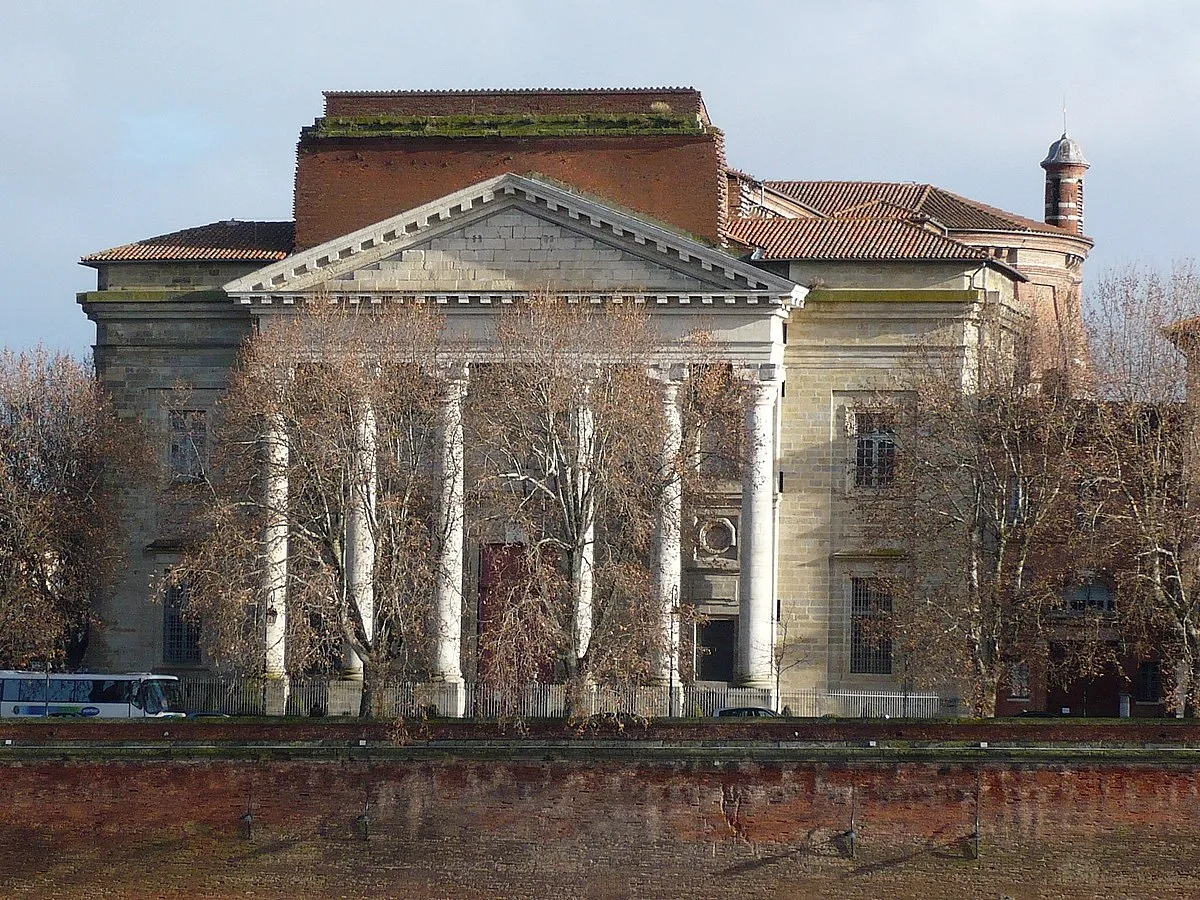
The Basilica of Notre-Dame de la Daurade, also known as Sainte-Marie la Daurade, is a distinguished minor basilica located in the heart of Toulouse, France. Its origins date back to 410 AD when Emperor Honorius decreed that pagan temples could be converted into Christian places of worship. This marked a pivotal moment in the basilica’s history, as the original structure on this site was a temple dedicated to the god Apollo. Over time, this ancient place of worship evolved into one of Toulouse’s most significant Christian landmarks.
Today, Notre-Dame de la Daurade stands proudly along the banks of the Garonne River, near a square and port that share its name, offering a beautiful riverside setting. The basilica is also adjacent to Toulouse’s School of Fine Arts, enriching its cultural surroundings. Known for its architectural beauty and spiritual importance, Notre-Dame de la Daurade has held the title of minor basilica, further elevating its religious status within the region.
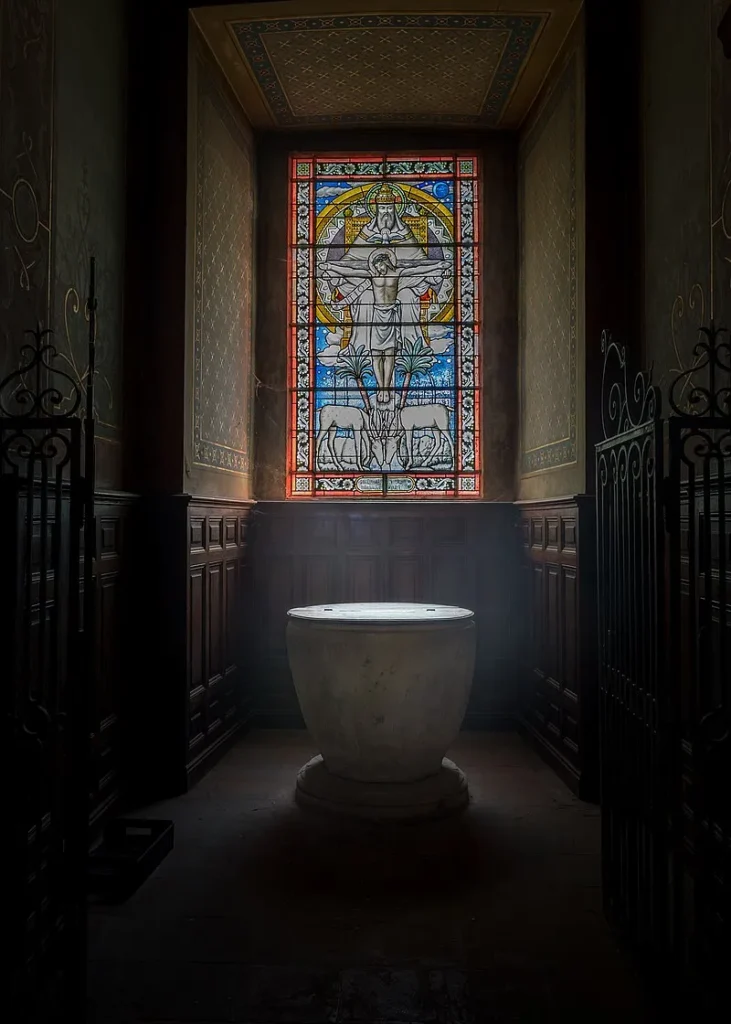
The History of the Basilica of Notre-Dame la Daurade dates back to the 5th or 6th century, when a church was erected and adorned with golden mosaics. Its name comes from the Latin Deaurata, meaning “covered in gold,” reflecting the church’s early decoration. Inscriptions found with the mosaics suggest that the church was originally used by the Visigoths, who practiced Arian Christianity, before it passed into Catholic hands following the Battle of Vouillé in 507. By the 9th century, it had become a Benedictine monastery. After a period of decline starting in the 15th century, the basilica was demolished in 1761 to make way for the construction of the riverside quays of Toulouse. Despite the demolition, the church was rebuilt, but the monastery was closed during the French Revolution and repurposed as a tobacco factory.
The basilica once housed the shrine of a Black Madonna, known as Notre-Dame la Noire. The original icon was stolen in the 15th century, and the first replacement was burned by revolutionaries in 1799 at the Place du Capitole. The current icon, a copy of the 15th-century Madonna, was created in 1807. Over time, the icon became known as Notre-Dame la Noire, darkened by candle smoke. The present church was constructed during the 19th century and consecrated in 1836. It was designated as a basilica by Pope Pius IX in 1876, two years before the Basilica of Saint-Sernin. Although it was not fully completed until 1883, the basilica’s significance has been long recognized. It has been classified as a Monument historique by the French Ministry of Culture, and its organ is also classified.
The church was built upon the remains of a dodecagonal Roman temple, likely dedicated to Apollo, which was repurposed by the Roman emperors for Christian worship. The devotion to the Virgin Mary, particularly in the form of a Black Virgin, became more prominent after the Council of Ephesus in 431, which defined new dogmatic teachings regarding the Virgin. This may have influenced the construction of the church, initially known as the Basilica of Saint Mary of Toulouse. In the 9th century, the church became part of a Benedictine monastery. By the 11th century, the dodecagonal structure was extended with a Romanesque nave. In 1077, the church was attached to the Abbey of Moissac, which itself was dependent on Cluny, and the monastery was expanded to include a cloister. The original dome was destroyed in 1703 after it was deemed structurally unsafe, and a new dome was installed in 1760, further compromising the stability of the building. By 1761, the church was in such poor condition that it had to be demolished. Reconstruction plans began in 1764 but were delayed in favor of the Garonne quays construction.
An ambitious new design was proposed, intended to replicate the Basilica of Saint Peter in Rome. However, the project was revised, and the original choir was relocated under the transept. The work was interrupted by the French Revolution, but the basilica was eventually consecrated in 1836. It was recognized as a basilica by Pope Pius IX in 1876, just before the Basilica of Saint-Sernin. The building was not truly completed until 1883. Today, the Basilica of Notre-Dame la Daurade also houses the remains of the poet Pierre Goudouli, whose statue stands in the garden at Place Wilson. The devotion to Notre-Dame la Daurade remains a subject of scholarly study, reflecting its long-standing cultural and religious significance.
The site of Notre-Dame de la Daurade, nestled along the riverside in Toulouse, was originally home to a temple dedicated to Apollo, the ancient Greek sun god. This temple was converted into a Christian church in 410 AD, following a decree from the Roman Emperor Honorius that allowed pagan temples to be repurposed for Christian worship. The present structure, built in the 19th century, reflects the neoclassical architectural style, with its grand façade and elegant columns.
Today, Notre-Dame de la Daurade is known not only for its spiritual heritage but also for its cultural events. The basilica regularly hosts orchestral concerts, with its majestic grand organ often taking the spotlight during performances. While exploring the building, be sure to visit the chapel that holds the rare Black Madonna of Toulouse, known as Notre-Dame la Noire. This revered statue is considered the protector of the city and a special guardian for expectant mothers, embodying a long-held local tradition of devotion and care.
Notre-Dame de la Daurade: A Historic Riverside Basilica with Classical Elegance
Notre-Dame de la Daurade is a church in Toulouse with a classical façade that gives the impression of lacking a bell tower. However, from across the river, a small, modest bell tower becomes visible, adding to its understated charm. Rebuilt entirely at the end of the 18th century, the church stands on the site of one of Toulouse’s most ancient religious buildings, thought to have once served as the chapel of the Visigothic kings. The apse of this early structure was decorated with paleochristian golden mosaics, inspiring the name Daurada, or “golden.” Later, it became the seat of a Benedictine abbey, led by priors who were significant figures in medieval Toulouse. The church was flanked by mills along the river until the 14th century and overlooked Toulouse’s main bridge, the Pont de la Daurade, from the 12th to the 17th centuries, reinforcing its importance in the city’s daily life. On February 1, 1963, Notre-Dame de la Daurade was officially classified as a historic monument, recognizing its architectural and cultural value.
Architecture of the Basilica of Our Lady of the Daurade, Toulouse, France
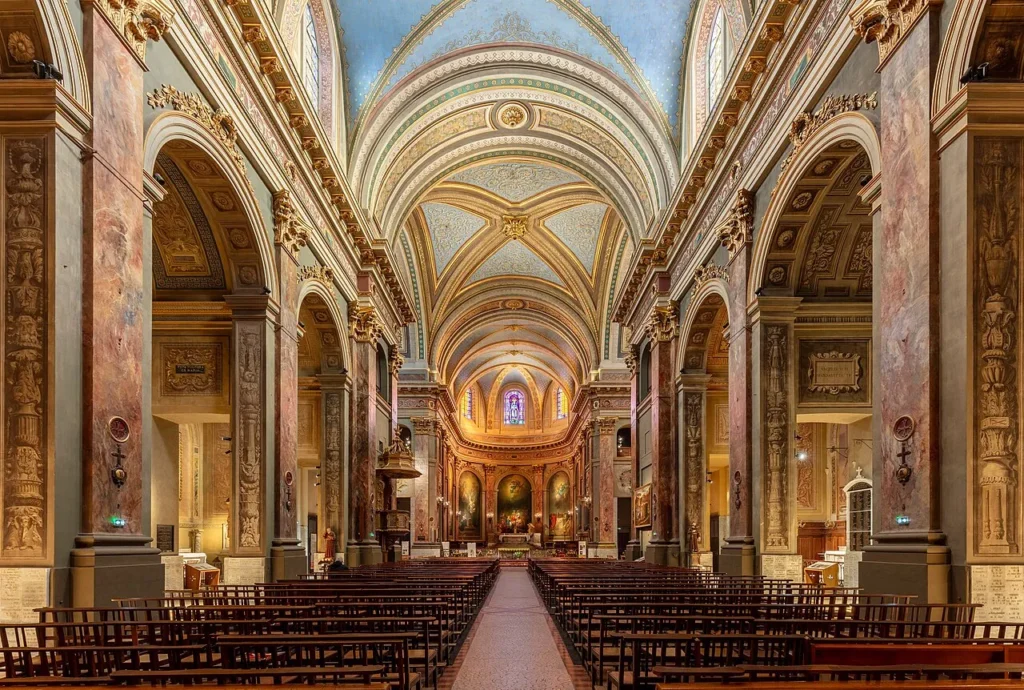
Architectural Style: Neoclassical Architecture
The Basilique Notre-Dame de la Daurade in Toulouse is an architectural gem that reflects the complex and evolving history of the site. The current basilica, reconstructed after the original structure was demolished in the 18th century, showcases a blend of neoclassical design elements. The building is marked by clean lines, symmetrical proportions, and classical ornamentation that are characteristic of the neoclassical style, which was popular in the late 18th and early 19th centuries.
A Stunning Interior
Upon entering the basilica, visitors are immediately struck by the grandeur of its interior. The space is adorned with monumental paintings that illustrate the life cycle of the Virgin Mary, painted by the esteemed artist Joseph Roques. These works enhance the spiritual atmosphere of the church, depicting key moments of the Virgin Mary’s life and offering a visual journey through Catholic devotion and the sacred narrative. The cycle of paintings not only adds to the aesthetic beauty of the basilica but also underscores the religious significance of the site.
Restoration of the Basilica of Notre-Dame la Daurade: A New Era of Preservation and Devotion
The exterior, interior, and furnishings of the Basilica of Notre-Dame la Daurade were thoroughly cleaned and restored after 26 months of work, from the fall of 2017 to December 2019, under the direction of heritage architect Axel Letellier. The restoration project, which cost 5.7 million euros, marked the first major restoration since the basilica’s construction.
The official inauguration took place on December 8, 2019, coinciding with the feast of the Immaculate Conception, and was attended by Mgr Robert Le Gall, Archbishop of Toulouse. During the restoration, the bell tower, which had been at risk of collapsing, was reinforced. For the first time in 70 years, the bells of the basilica rang in celebration of the event. In addition, all of the basilica’s furniture is set to be classified as historical monuments. Since the completion of the restoration, the basilica has been open daily for visits, except during liturgical times, which are reserved for the faithful.
Black Virgin
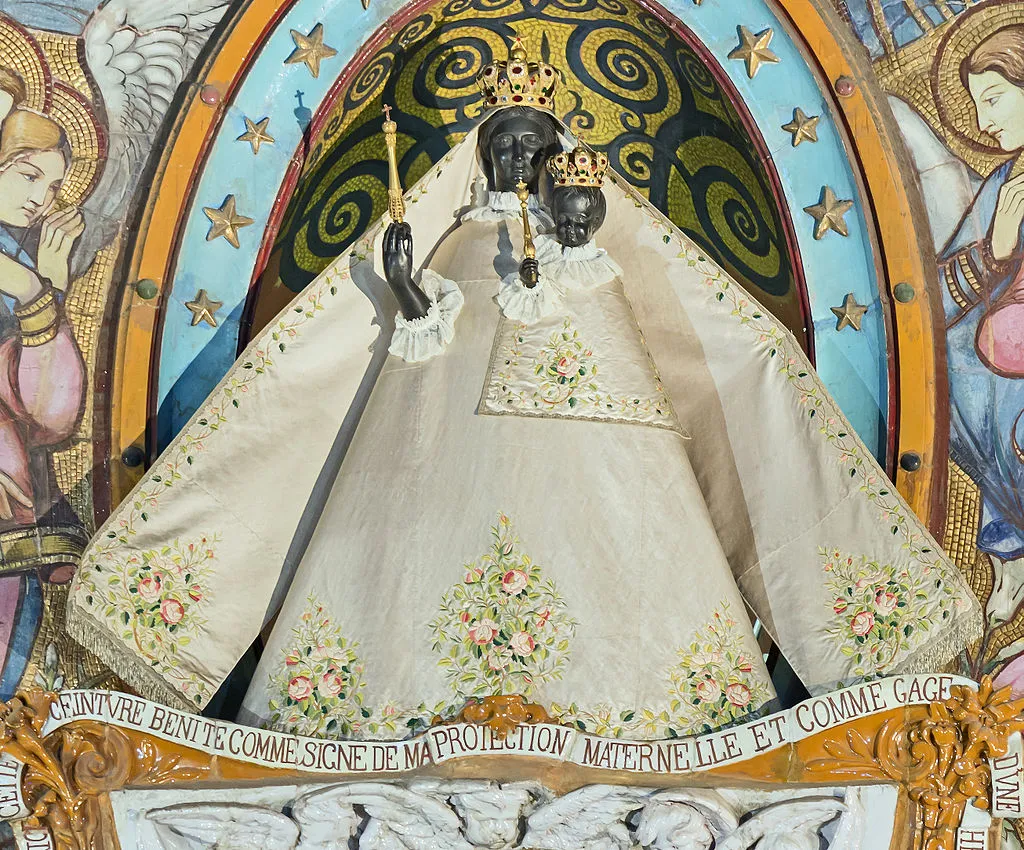
The Basilica of Notre-Dame la Daurade is home to a notable and revered Black Virgin statue, a key feature of its religious identity. The current statue, a copy of the original, is a second version of the “brown virgin” that was first known in the 10th century. The cult surrounding this Black Virgin is particularly associated with the protection of pregnant women. The original statue was stolen in the 14th century and then replicated. The most famous Black Virgin is La Moreneta in Montserrat, Catalonia, often referred to as the “Brunette” or “Black Virgin” due to the effect of candle smoke darkening her appearance over centuries. Similarly, the statue in Toulouse, from the 16th century onwards, became known as Notre-Dame la Noire due to the accumulated soot from candles.
This statue has long been attributed with miraculous powers. One of the most famous miracles is its intervention during a fire in the Saint-Michel district in 1672. However, during the French Revolution, the statue was burned in 1799 in the Place du Capitole. In 1807, a new statue was sculpted, based on memories of the original. Standing about two meters tall, the current statue is crowned with a royal crown, which, along with the crown of the child, has been classified as a historical monument. The statue’s clothing is updated periodically with help from France’s premier haute couture houses. The ceramic decorations on the statue were designed by the artist Gaston Virebent.
The Organs
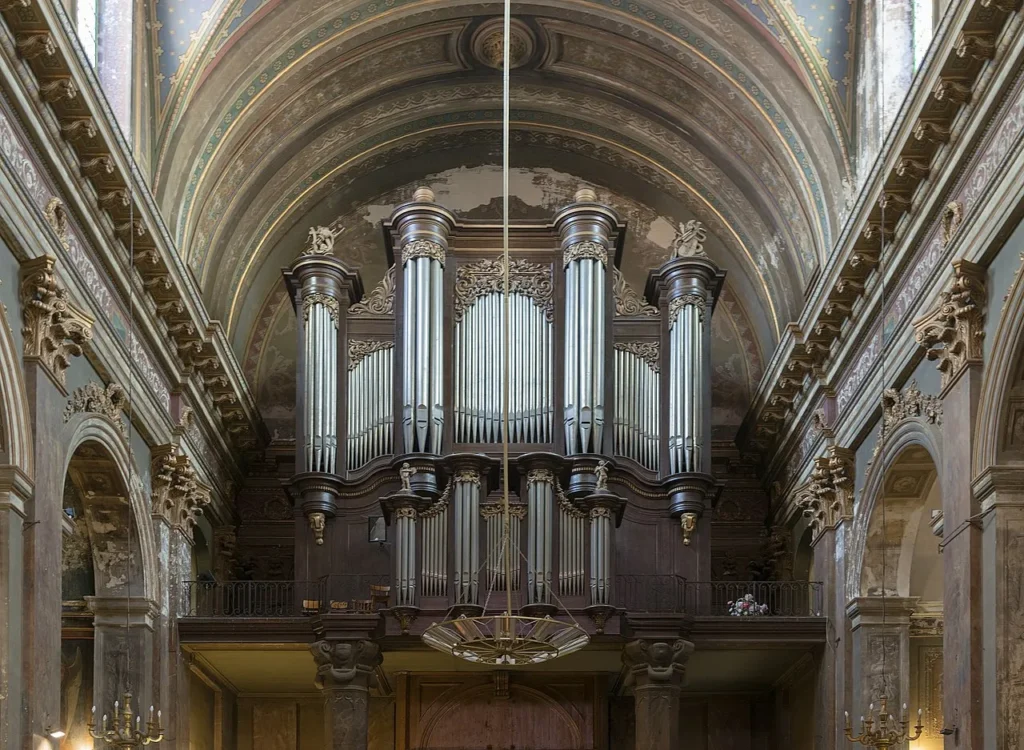
The Basilica of Notre-Dame la Daurade houses two significant organs: a gallery organ, which is classified as a historic monument, and a choir organ. These instruments contribute to the basilica’s rich musical heritage. The gallery organ is particularly noted for its historical value and impressive sound, complementing the basilica’s acoustics and architecture. Photos of the basilica taken in 2014, before its extensive restoration (which occurred from autumn 2017 to December 2019), offer a glimpse into the state of the building prior to the major preservation efforts.
The Bells
The Basilica of La Daurade has a modest circular bell tower situated on its roof, positioned between the south transept and the choir. By 2017, the basilica’s bell set consisted of five bells. Of these, two large bells were capable of ringing on the fly, while the other three were fixed: B3, D#4, F4, F#4, and G#4. Four of these bells were cast in 1845 by Toulouse bellmaker Jean-Louis Louison, with an additional bell cast in 1816 by Châtelet. As part of the 2018 restoration, the bells were retuned, and two new bells were added (C#4 and A#4). The F4 bell, which could not be retuned, was replaced.
Here is a list of the newly updated bell set:
- B3 – 260 kg
- “Maria Dauratae” (C#4) – 225 kg, cast in 2018 by Paccard d’Annecy
- D#4 – 125 kg
- “Peire Garona” (F4) – 115 kg, cast in 2018 by Paccard d’Annecy
- F#4 – 70 kg
- G#4 – 60 kg
- “Benoît” (#4) – 52 kg, cast in 2018 by Paccard d’Annecy
The names of the three new bells were chosen for their symbolic and local connections:
- “Maria Dauratae” is named in reference to the basilica’s dedication.
- “Peire Garona” honors Pierre Goudouli, a renowned poet from Toulouse (1580–1649), whose ashes are kept in the basilica.
- “Benedict” is named after Saint Benedict, the patron saint whose rule inspired the Benedictine monks who built the church.
This restoration aimed not only to preserve the bells but also to enhance the musical heritage of the basilica, allowing the bells to play a key role in the cultural life of Toulouse.
Casting of New Bells
On September 15 and 16, 2018, the new bells of the Basilica of La Daurade were cast publicly at the Quai de la Daurade during the European Heritage Days. The casting process began on Saturday evening at 10 p.m., and the bells were demolded the following Sunday at 10 a.m. Afterward, they were sent to the Paccard foundry in Annecy for polishing and tuning before returning to Toulouse. The bells were officially inaugurated during a baptism ceremony on April 7, 2019, at the 11 a.m. mass. The casting sequence began with the smallest bell and progressed to the largest. During the casting of the medium bell, an unexpected leak in its mold caused 30 kg of molten bronze to escape. The leak was quickly sealed, allowing the bell to be completed. However, this issue resulted in a shortage of metal for the large bell, which required additional metal to be cast. The bell’s final structure, including the upper part, was remade at the Paccard foundry in Annecy. This process ensured the successful casting of the bell “Peire Garona,” though it came at the cost of the larger bell, “Maria Dauratae.”
A Goal of Restoration
As part of the restoration of the Basilica of La Daurade, one of the objectives was to adjust the bells so that their notes could play the opening of Claude Nougaro’s song “Toulouse” (originally titled “O Toulouse”), which became a city anthem after its release in 1967. Nougaro was inspired by the melody of the carillon at the Minimes Church in Toulouse, which he heard as a child. The tune, likely a 19th-century Marian hymn, had been programmed into the church’s clock mechanism during its renovation in 1892. By restoring the bells to their original pitch, the intention was to recreate this lost melody in a new bell tower, echoing the sound that once influenced the composer. This connection between the bells and the city’s musical heritage aims to revive a historical sound and deepen the cultural bond between the city’s past and present.
The Choir
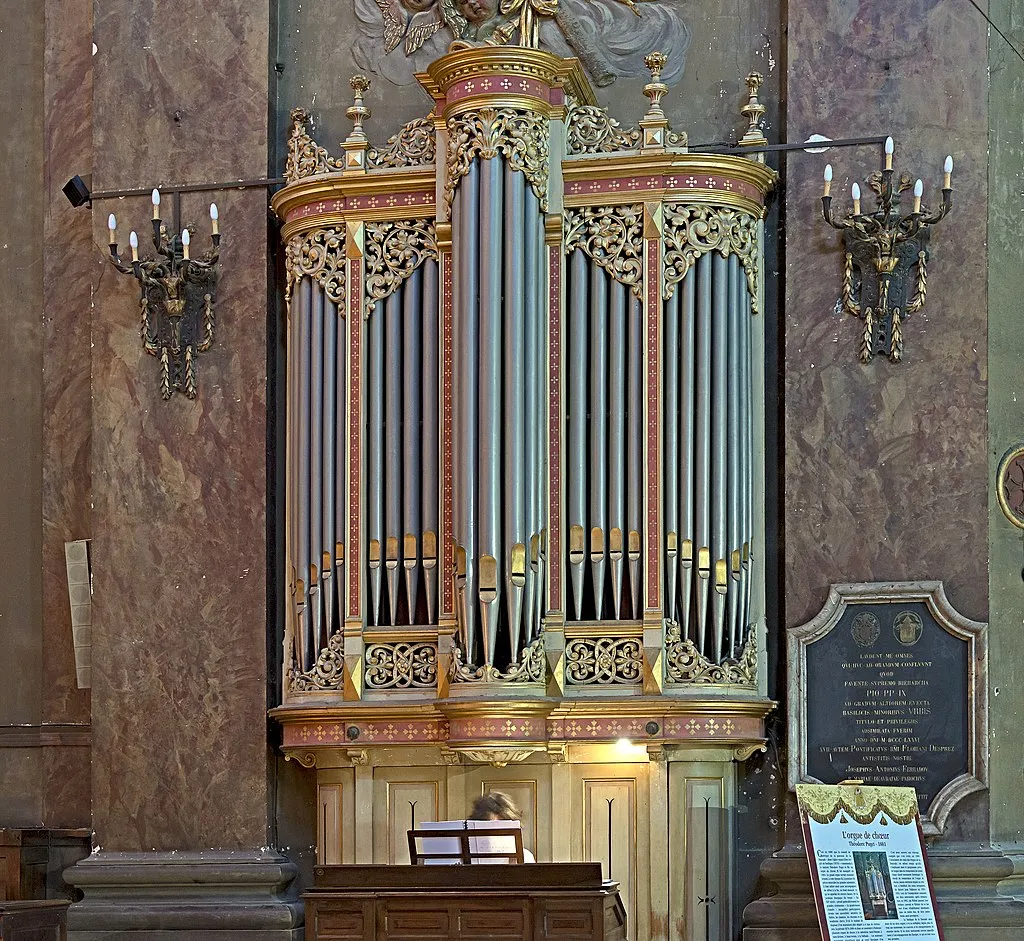
The Basilica of La Daurade features several notable religious artifacts, including two gilded wooden angels positioned on either side of the altar. These angels were created by the Toulouse sculptor Jean-Louis Ajon in 1812. In addition, the basilica houses various religious objects such as chalices, gospel manuscripts, ciboria, and other sacred items. On either side of the high altar are a pair of Louis XIV-style wall tables, further enhancing the church’s historic and artistic appeal.
The Chapels
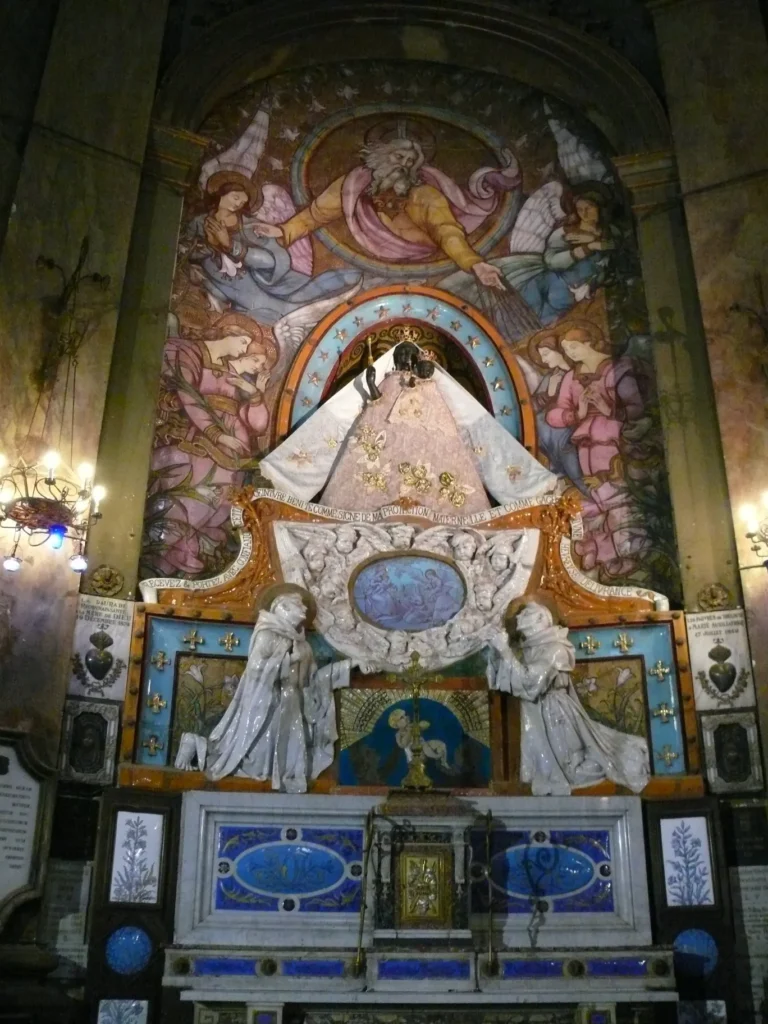
On the right side of the nave of the Basilica of La Daurade, you’ll find the monument dedicated to those who perished in the First World War, situated between the chapels of the Sacred Heart and the Guardian Angel. The monument serves as a somber reminder of the lives lost during the conflict. Several notable paintings adorn this area, including Christ on the Cross between Two Thieves, The Mystical Wine Press, Christ on the Cross, and The Crowns and Scepters of the Black Virgin and Child. These artworks contribute to the spiritual and historical significance of the space, linking both religious devotion and the solemnity of the war memorial.
Floral Games
Every year on May 3rd, a special Mass is held in the Basilica of La Daurade to bless the trophies of the Academy of Floral Games—gold and silver flowers that are awarded to the winners of this historic institution. These trophies, which are placed in the church as part of a long-standing religious tradition, are later transported to the Academy’s session, where they are presented to the honorees. Historically, the trophies were carried back in procession by three capitouls-bailes (municipal officials), accompanied by three commissioners from the Academy, followed by the sound of trumpets and oboes. In contemporary times, however, a delegation of maintainers takes on the task of bringing the flowers to the Capitol for the award ceremony, which takes place in the Hall of the Illustrious. This annual event continues to honor both the literary traditions of Toulouse and its historical customs.
The Daurade mills
The prior of La Daurade once held significant lordship over portions of the Garonne River’s course in Toulouse, a position that enabled him to collect various rights from the late 12th century. Among these were rights to the Moulins du Bazacle and the Moulins de La Daurade, which operated actively throughout the 13th century. However, these mills were eventually rendered nonfunctional in 1356 due to the raising of the Bazacle causeway, which blocked their operations and led to the ruin of their owners.
Feast Day
Feast day: 15 August
The Annual Feast Day of Basilica of Our Lady of the Sea Bream, Toulouse, France, is celebrated on August 15 each year.
Church Mass Timing
Monday : 11:00 AM – 6:00 PM
Friday : 6:30 PM
Saturday : 6:00 PM
Church Opening Time:
Monday : 9:00 am – 6:00 pm
Tuesday : 9:00 am – 6:00 pm
Wednesday : 9:00 am – 6:00 pm
Thursday : 9:00 am – 6:00 pm
Friday : 9:00 am – 6:00 pm
Saturday : 9:00 am – 6:00 pm
Sunday : 9:00 am – 6:00 pm
Contact Info
Address :
1 Pl. de la Daurade, 31000 Toulouse, France
Phone : +335612138 32
Accommodations
Connectivities
Airway
The Nearest Airport to The Church of Basilica of Our Lady of the Sea Bream, Toulouse, France, is, Toulouse-Blagnac Airport (TLS), Blagnac, France, which is just 17 min (8.8 km) via A621 away from the basilica.
Railway
The Nearest Railway to The Church of Basilica of Our Lady of the Sea Bream, Toulouse, France, is, Colomiers Train Station 31770 Colomiers, France, which is 19 min (11.1 km) via A624 away from the basilica.








